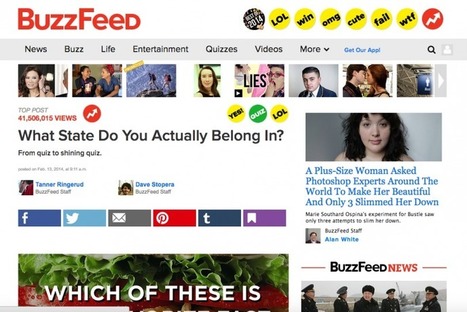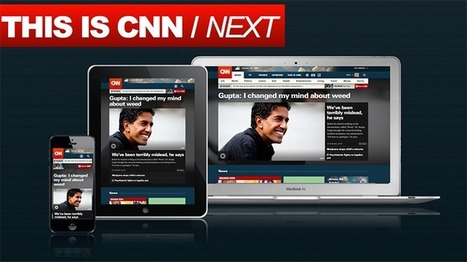 Your new post is loading...
 Your new post is loading...
It’s been a remarkable year for the nation, and its press. Transfixed by the Trump phenomenon, election anxiety has all but consumed us. But soon, what has felt like a national colonoscopy will soon be over, and the press will march (or at least step) forward. As we consider the most newsworthy U.S. press happenings of this year, let’s start projecting forward to 2017. Tronc may well disappear early into it, but in a sons-also-rise scenario, the Murdochs and the Sulzbergers maintain center stage, and the future of Gannett and GateHouse — two companies that collectively own almost one in five U.S. dailies — becomes even more important. Let’s take 10 storylines of 2016 and extend them into the year ahead....
Amid widening concerns that another startup bubble has formed, digital media remains a white-hot market among the private-investment community.
Last year, venture capital poured at least $683 million into digital media companies worldwide -- more than twice the $277 million invested in 2013, according to Preqin, which tracks venture-capital investments.
That investment comes as traditional media companies like The New York Times and Condé Nast cut staff, trim costs and turn over every possible rock in search of new revenue streams. Meanwhile, digital media companies -- which have a fraction of old media's revenue and even less of their profits -- are awash in investor cash....
For a moment, let’s not focus on the delicious irony of Buzzfeed breaking the second biggest news about The New York Times this week. The site -- which many a Times staffer probably sniffs derisively at -- uploaded the paper-of-record’s entire 91-page “Innovation Report” that calls for de-emphasizing print in favor of a more sophisticated approach to digital. If you’re in digital, it’s even more intriguing than the news on Wednesday that executive editor Jill Abramson had been unceremoniously shown the door.
More than anything else, the report points to the Times’lackluster, scattershot approach to digital innovation, particularly in audience development, an imperative when so much content and readership comes from the act of sharing. In one of its many trenchant-but-obvious observations, it points out that “our digital content needs to travel on the backs of readers to find new readers.”...
This is what UPI's 100 years of journalistic excellence has pathetically come down to.... - 4 of its top stories are about misbehaving celebrities. The other is about whether a naked photo that went viral was staged. - 4 of its top stories are about naked people; 2 of its top stories contradict each other. And considering that the 5th story could have been fact-checked by just watching the video in question, that means UPI ran a story for hits without even watching the video. - 3 of the stories are not even about Miley Cyrus, they’re about celebrity reactions to her routine....
...Today, the delivery of news is not so defined. Website, social media and digital platforms have profoundly changed not only how we get our news, but also what news we are getting. The comment section of online news stories are often more popular, or at least more entertaining, than the actual news story. The ability to “like” and “share” news now allows others to instantaneously watch or read what we are following.
As the number of online and social media offerings grows, we are sadly seeing the demise of newspapers. In 2011, 152 American newspapers ceased operations. Rapidly declining advertising revenues continue to be the industry’s core problem as the majority of us seek our news online.
Now, plans are in place for significant changes for CNN.com and CNN digital platforms. The channel will launch a redesigned website (see screenshots here) and install a back-end system that its editorial producers can utilize. This comes after the recent merging of their digital and television newsrooms into one entity. With a new emphasis on their talent, CNN anchors, reporters and writers will become more prominent, enabling the sharing of content across platforms....
When it comes to political scandal, why is the media is so out of step with its audience?
Spitzer and Weiner, with their cohorts around the country, are a slap in the media's face. Scandals, after all, are largely media created. You can hardly have a scandal without the media treating it as scandal — Spitzer's and Weiner's being among the tastiest of recent years.
There's a vested interest here. The media is defending its own work. The easy rehabilitation of the badly behaved refutes, if not the facts, certainly much of the media's damnation.While the media has been the instrument of running the offenders out of office, the public wants them back....
One of the biggest complaints about online advertising is that we’ve exchanged print dollars for digital dimes.
One response has been: Well you better start stacking dimes.
The dollar to dime problem is at the heart of journalisms existential woes. I suspect if money were rolling in like it used to, the question of “who IS a journalist” wouldn’t be so passionately debated.
There is a moment I’ve called “the Screenularity“ - it is the moment when consumers do not make a functional distinction between the screens in their life. One can watch video on their handheld screen, one can make a call on the 40-inch screen in their living room. One is not called a “phone” or the other a “TV.”...
I am often asked what it takes to be a great reporter in the digital era. The essential mission, I say, remains the same: to observe, collect and interpret information. Don’t be a generalist; pick a subject, dig deep into it, bring “passion” to the job. That word evokes the obligatory question about objectivity. My response: journalism has always entailed biases, conscious or not. Next, a great reporter engages one-on-one with news consumers, joins social news streams, learns to be a marketer and plays with the technology. I end with this: understand the business models behind the profession — and start to think like an entrepreneur. FORBES has 1,000 writers learning and practicing all of that. Here are four who are leading the way...
Twitter is a frenemy," said Jeff Zucker, CNN's new president, as reported by MediaShift. Jeff Zucker was describing the cable news network's relationship with social media and added, “the network uses, relies on -- and is scared by -- social media.” Twitter had a marquee moment last week, particularly late Friday afternoon and evening, that should scare most television news outlets in the business of reporting breaking news. That’s when Boston Marathon bombing suspect Dzhokhar Tsarnaev was cornered by police, trapped and almost bleeding to death inside a covered boat in a backyard in Watertown, Mass....
As news surges on the Web, news giants are being outmaneuvered by smaller sites that have passionate audiences and sharply focused information. It was a rough week for the big guys on the Web. Yahoo unceremoniously dumped its chief executive, Carol Bartz, and AOL faced a mutiny from TechCrunch, the Silicon Valley news site it bought last year. Apart from the specific business issues feeding those travails — sinking traffic and profits at both — they provided yet another lesson of the Internet age: as news surges on the Web, giant ocean liners like AOL and Yahoo are being outmaneuvered by the speedboats zipping around them, relatively small sites that have passionate audiences and sharply focused information....
|
Ozy, Refinery29, Business Insider, Vox, and Buzzfeed are among the news and media startups valued over $100M.
Venture capital and strategic investors ranging from Comcast to Time Warner to Bertelsmann poured nearly $800M into digital news and media startups last year. The huge fundings are leading to some very robust valuations in the content business.
Notably, Buzzfeed and Vox Media each took investments of $200M from NBC Universal earlier this year, placing them in the now 139-member strong unicorn club. Now, Axel Springer has acquired Business Insider, valuing the company at $442M just 7 years after launch....
A 96-page internal New York Times report, sent to top executives last month by a committee led by the publisher’s son and obtained by BuzzFeed, paints a dark picture of a newsroom struggling more dramatically than is immediately visible to adjust to the digital world, a newsroom that is hampered primarily by its own storied culture.
The Times report was finalized March 24 by a committee of digitally oriented staffers led by reporter A.G. Sulzberger. His father, Times Publisher Arthur Sulzberger, fired Executive Editor Jill Abramson Tuesday, a decision that doesn’t appear immediately related to the paper’s digital weaknesses.
The report largely ignores legacy competitors and focuses on the new wave of digital companies, including First Look Media, Vox, Huffington Post, Business Insider, and BuzzFeed....
2013 essay excerpted from BU professor Chris Daly's book...
The word “crisis” often comes up when talking about journalism in the U.S. and throughout the world: Dropping ad revenue, falling circulation, failed efforts to retool old models to fit a changing media landscape. As the blogosphere and Twitter rise, more opinionated kinds of media coverage push back against the longstanding ideals of impartiality and objectivity, and even the once sacrosanct authority of mainstream journalism is called into question.
But as many journalists, authors and researchers have noted, U.S. journalism has been in transition since its birth, from early broadsides of the revolutionary era through the disruptive entries of radio, television and now the Internet. In his 2012 book, Covering America: A Narrative History of a Nation’s Journalism, author and Boston University journalism professor Christopher B. Daly places the current state of journalism within its recent historical context. Below is an essay based on the book....
In the wake of the Boston Marathon bombing one commenter called it a “watershed moment for social media” – but not in a good way. “Legions of Web sleuths cast suspicion on at least four innocent people, spread innumerable bad tips and heightened the sense of panic and paranoia,” wrote Ken Bensinger and Andrea Chang in the L.A. Times. In a similar post, Alan Mutter quipped that crowd reporting after the Boston Marathon went from critical mass to critical mess.
Recent events like Hurricane Sandy and the Boston marathon bombing have cast a harsh spotlight on the brave new world of breaking news and highlighted the critical need for better tools and techniques for verifying and making sense of the flood of information these events produce. This has all played into the ongoing debate about whether the Internet and new technology erode our standards and our trust in newsgathering....
How do you get your news? Personally, I get mine primarily from Facebook. As my job requires that I monitor and update different brands' pages, it's pretty likely that you'll find me with the Facebook tab open.... While I may be an addict—I mean hello, it is my job—I am not the only one who scours social networks for news. According to a Pew study, one third of adults under 30 access their news via social networks. 19% of all Americans got news from a social network like Facebook, Google+ or LinkedIn yesterday (up from 9% in 2010). This study was conducted in 2012. Being that we're now in 2013, I can only imagine it being a higher percentage to date....
BuzzFeed gets free content, users get exposure, we get 11 Engagement Photos That Will Make You Happy You’re Single. ... The department devoted to creating this “old school” content is known as BuzzTeam. Their focus is anything shareable — lists, animals, nostalgia. The kind of content that BuzzFeed’s loyal readers have become hyper-familiar with. Many, in fact, have consumed so many such BuzzFeed posts that they’ve become adept at mimicking both their tone and their viral success. Earlier this month, BuzzFeed’s editors took a step toward giving those faithful followers a little more of the spotlight they crave. Shepherd, along with a staff of four, now run BuzzFeed Community, a content-producing vertical of its very own, complete with featured posts by community members and a leaderboard with the latest on who’s posts are getting the most traffic, likes, comments, and badges. It’s a competitive place, and anyone can join and enter the fray....
The NYT’s multimedia project Snow Fall was a huge success, attracting big audiences and lots of plaudits. ...Snow Fall (and other such attempts) represent a great opportunity and the future for news organizations like The New York Times, especially as they are right now in a losing battle for attention with upstart competitors that include everyone from BuzzFeed to The Huffington Post. If you are the New York Times management, it is time to take a gamble: spend $25 million on creating 100 Snow Fall-like projects.... And in exchange, it got a few million page views, but I am guessing they also built a nice backend infrastructure to create more such projects. As a result, the next Snow Fall is going to cost less, with most future spending going to the creative: words, photos, other multimedia elements and design. So what will the Times (or someone like them) need to get it done? Simply put, a departure from the incumbent thinking, embracing today’s reality and re-imagining the work flow of a big city newspaper. In other words: Re-imagining its business model to factor in the reality of today’s world and forget the legacy of newsprint.Create a new breed of “producer” who can switch between Excel and content.Create a whole new breed of a journalist — one who has old-school values but also the ability to tell a story that works in many mediums of today.Build an editorial creative machine that works differently from a print-centric editorial group....
Marketers plan to spend less on newspapers, consumer magazines, radio, trade magazines and TV; Winners are mobile media, social media and marketing automation.... Perhaps marketers are simply reflecting the interests of the audiences they want to reach. Alan Mutter gathers some statistics that point to ominous demographic trends: Only 6% of people in their 20s and 16% of 40-year-olds regularly read newspapers, compared to 48% of people over 65. Only 29% of the U.S. population regularly read a newspaper in 2012, down from 56% in 1991. Three-quarters of the audience at the typical newspaper is 45 years of age or older. In comparison, over-45s comprise only 40% of the population. Print advertising still generates between 80% and 90% of revenues at the typical major metro daily. Mutter asserts that newspaper publishers will never pull out of their tailspin unless they can create products that appeal to the new generation of digital natives who can’t be bothered to drag around paper, CDs or books. For them, the phone and the tablet are their windows on the world, and that will change industries ranging from news to travel to banking....
|



 Your new post is loading...
Your new post is loading...






























Ken Doctor has storylines that will still be interesting in 2017..